Proceedings of the Tenth International Conference on Conceptions of Library and Information Science, Ljubljana, Slovenia, June 16-19, 2019
Materiality and embodiment in collaborative knowledge processes: Knowledge creation for a virtual power plant
Anna Suorsa, Teemu Suorsa and Rauli Svento.
Introduction. The study introduces a theoretical framework for examining knowledge creation and results of an empirical examination, based on hermeneutic phenomenological approach, emphasising the dialogical, embodied nature of human beings, who act and interact in their material environment.
Method. Ethnographic approach, focusing especially on the interactive events, is used to examine the process of knowledge creation in a multi-disciplinary research community, developing scientific knowledge for a virtual power plant.
Analysis. Video materials, observational data, field diary and documents were analysed in different stages, focusing on the content of the discussions, modality of interaction and the phenomena of knowledge use, sharing and creation in the process.
Results. The analysis of the videotaped discussions in relation with the data from the longer knowledge creation process of a virtual power plant suggests that to create interdisciplinary knowledge, there has to be means and tools to move flexibly from ideation and verbal discussions to more detailed means of sharing, using and creating scientific knowledge.
Conclusions. Examining knowledge creation as a dialogical, hermeneutic process enables us to see, how the problems faced can be understood and solved by acknowledging the embodied nature of the human beings, their limits and possibilities.
Introduction
Work life and organisational circumstances are changing rapidly, and organisations are developing new practices to create new knowledge and innovations. In the field of Knowledge Management, different models for organisational knowledge creation, based on interaction, have been introduced (Nonaka, 1994; Tsoukas, 2009). It has been acknowledged, that new knowledge is created in interaction, as people share their knowledge and start to question their own old presumptions. Hence, it has been suggested, that face-to-face discussions should be included in the examination of knowledge creation in organisations (Tsoukas, 2009; see also Cook and Brown, 1999). However, face-to-face discussions are part of longer knowledge creation processes, which are complex systems of different kinds of interactions and working phases, starting from the development of the ideas and ending up in new solutions, innovations or practices. In those processes, different tools and practices are used to shift between verbal discussions and other means of interaction to create, share and use knowledge and information in the process (Savolainen, 2009; White, 2007; O’Farrill, 2010). Thus far, the significance of the discussions in those processes has not been empirically examined. In addition, there is a lack of empirical research on how new knowledge is created in face-to-face discussions, where both verbal and non-verbal communication is used. Hence, there is a need for further development of theoretical conceptualisations and tools to understand organisational knowledge creation from a unified and more holistic perspective.
To fill these gaps, this study introduces a theoretical framework for examining knowledge creating interaction empirically and presents results of an empirical examination, based on hermeneutic phenomenological approach, emphasising the dialogical, embodied nature of human beings, who act and interact in their material environment (Suorsa and Huotari, 2014; Merleau-Ponty, 2006). A process of creating knowledge for a virtual power plant is examined ethnographically in a multidisciplinary research consortium, concentrating on the multi-modal analysis of the interaction in the knowledge process and the tools and practices used to create more accurate and specific scientific knowledge together.
The research questions are:
- How is the dialogical and embodied nature of the human beings shaping the knowledge creation process?
- How is the knowledge creation process intertwined with the practices of sharing and using knowledge and information?
We focus on the analysis of multimodal video material, to fill in the gap in the research of interactive practices in the field of Library and Information Studies (e.g. Budd, 2006; McKenzie, 2009, 2010). Our study contributes also to the studies, which use phenomenology and hermeneutics to understand the concepts of information and knowledge and the phenomena related to them (Hoel, 1992; Budd, 2001; Budd, 2005; Hjørland, 2005; Hansson, 2005; Suominen, 2016).
Theoretical background for examining knowledge creation with hermeneutic phenomenology
The phenomenon of organisational knowledge creation has been vastly examined in recent decades, and models to describe and define the knowledge processes have been developed (e.g. Alberts, 2007; Olsen, 2009; Auernhammer and Hall, 2014; Koloniari et al., 2018). In the famous model of knowledge creation by Nonaka (1994) and his colleagues (e.g. Nonaka and Takeuchi, 1995), the basis of knowledge creation is in interaction, where knowledge is converted from explicit to tacit, and vice versa. Also other models and approaches to knowledge creation emphasise interaction between different elements (Cook and Brown, 1999; Morner and von Krogh, 2009). Tsoukas (2009), for example, has been developing a thorough model of dialogical knowledge creation in organisations, which describes the interactive phenomena related to the verbal and multimodal interaction underlying the processes of developing new knowledge. In that model (Tsoukas, 2009), the process of creating new knowledge starts with unsettledness experienced in the organisation, which strives its members to find new distinctions by developing new orientations to known concepts and views. Tsoukas (2009) emphasizes, that creating knowledge in face-to-face discussions is both verbal and physical event, where human beings’ whole presence in the dialogue develops an atmosphere of being in a mutually shared discussion (see also Suorsa, 2017). However, the theoretical premises of the linkage between verbal and physical - or embodied - interaction in knowledge creation have not been fully explicated.
When examining interactive knowledge creation processes in empirical setting, it is important to understand, that these processes involve several knowledge processes and practices, which may also be present simultaneously, all contributing to the event. It has been acknowledged, that the definitions of knowledge creation, knowledge use and knowledge sharing often mix (Widén-Wulff and Davenport, 2007; Kosonen, 2008; Cyr and Choo, 2010; see also Ahmad and Widén, 2018; Huvila, 2019). Savolainen (2009) has noted, that the phenomena of information use, knowledge use and knowledge utilization are often used as synonyms, and also knowledge sharing and knowledge creation are often used interchangeably. In addition, the practices used in the events of knowledge creation come close to the embodied information practices, examined e.g. by Olsson (2016).
To be able to conceptualize and examine the phenomena described above, we need a coherent theoretical and methodological approach, which takes into account the complexity of the phenomena, and seeks to understand the phenomenon of organisational knowledge creation as a system, where human beings, knowledge and context are not separated, but understood as an entity. Hermeneutic phenomenology, deriving from the philosophers such as Martin Heidegger, Hans-Georg Gadamer and Maurice Merleau-Ponty, refers to the phenomenological tradition, which highlights the interpretive nature of human beings and their experiences. It gives us means to understand and investigate interaction in terms of hermeneutic event of understanding, where human beings act supported by the horizon of expectation created by his or her prior experiences Gadamer (1999, 2004). The hermeneutic event of interaction thus describes an interpersonal event of meaning creation and interpretation in a certain time and place, when a new, better explicated, and understood position towards a certain issue is created (Gadamer 1999, 2004). (See Suorsa and Huotari, 2014, Suorsa, 2015a; Suorsa, 2017.) Hermeneutic understanding of the interaction gives us means to examine the balance between having certain goals and intentions, but also openness for new interpretations in the process of knowledge creation. In this study, we focus on three important dimensions of phenomenology: 1) materiality, 2) dialogicality and 3) temporality of human beings, which simultaneously describe also the organisational circumstances and give us means to understand knowledge creation as a continuous process.
Materiality is understood in phenomenology as being-in-the-world (Heidegger, 1985): it does not make sense to talk about human beings as separated from their environment. Rather, we should always articulate human beings’ activities as specific openings with concrete connections to current objects and tools at hand (Heidegger, 1985). Human body denotes a specific place of this opening (Merleau-Ponty, 2006; Küpers, 2005; 2015; see also Järvilehto, 1998). Indeed, there is no other way of being in the world than as an experiencing body, which is unique, and of flesh and blood. This body and its experience is of a primary nature. (Merleau-Ponty, 2006.) Since human beings occupy different locations in space and time, we also perceive the world differently: The dialogical nature of human beings follows from the necessity to coordinate our activities in order to produce common results - and understand the results we are producing in our daily lives as human beings (Järvilehto, 1998). To understand that other human beings are bodily centers of intentions, who are similar to ourselves but live their unique lives, also necessitates the recognition of different life trajectories (Merleau-Ponty, 2006; Dreier, 2011) and orientations to the future (Suorsa, 2017; Suorsa, 2015b). The temporality in phenomenology means above all the idea of human beings being always already “ahead of themselves” (Heidegger, 1985), participating in producing the common results of action which go beyond individual intentions (Suorsa, 2017; Roth, 2007). In addition, the phenomenological concept of a human being is shaped by the idea of an open and questionable future, which is full of possibilities, in which human beings can seize the moment and understand their own opportunities, which are shaped by their past experiences (Heidegger, 1985).
Based on the phenomenological approach, the phenomenon of knowledge creation can be conceptualized as an event and an experience (Värlander, 2008; Suorsa and Huotari, 2014, 2016; Suorsa, 2015a; see also Olsson and Lloyd, 2017; Olsson, 2016). The experiential dimension of knowledge creation could be concentrated by examining the experiences of the participants involved in the knowledge creation process (Suorsa and Huotari, 2016). However, in this study, our focus is on examining the event of interaction as it is perceived. Framework of this study and the focus of the empirical examination are illustrated in Figure 1.
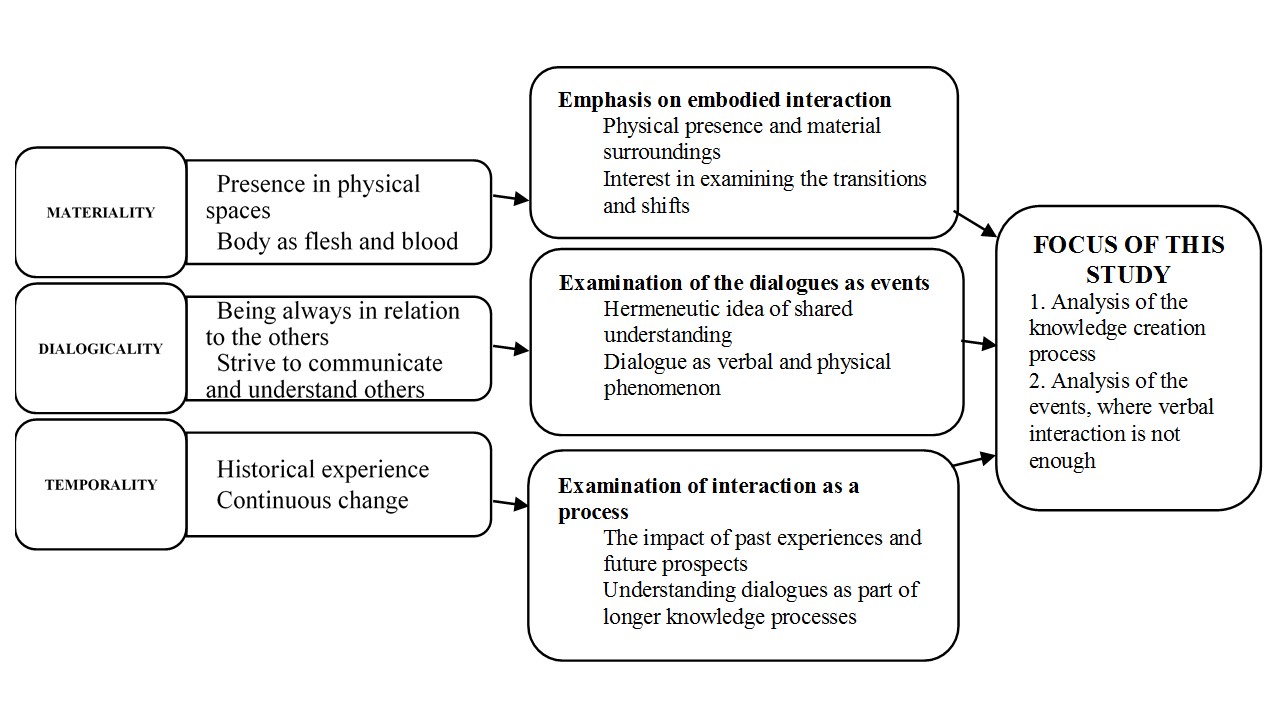
Figure 1: The framework for understanding and examining knowledge creation in this study.
Figure 1 illustrates, how the theoretical understanding of the phenomenon of knowledge creation has shaped the empirical examination.
Methods and data
Research environment and methods
The examination of the dialogical and embodied nature of human beings in the events and processes of knowledge creation shapes the methods used in this study. Understanding the phenomenon from the phenomenological point of view gives us some basic premises for the study: 1) we should take into account the temporality and materiality of human beings and concentrate on the actual events, where human beings act, interact and create new knowledge in the community, and 2) we should understand knowledge creation as a process, which includes change. (See Suorsa and Huotari, 2016; Moustakas 1994; Lopez and Willis, 2004.) Gadamer’s emphasis on language and interpersonal conversations (Linge, 2008) and Merleau-Ponty’s conceptualizations of the body and its surroundings affected the way of conducting the empirical study.
Thus, the study was conducted in the light of an ethnographical approach (Smith, 2001; Maso, 2001), concentrating on interaction in the face-to-face gatherings of a community of researchers and partners working in a research consortium in Finland, referred to as a research community in this study. The research community is a multi-organisational and multi-professional community, which includes researchers from two universities and five different disciplines: Energy Economics, Computer Science Engineering, Meteorology, Information Systems Sciences, and Information Studies. They form five research groups (RGs). In addition, there are two strategic partners and an Advisory Board, consisting of 15 private firms. The aim of the research community is to develop a digital marketplace for clean energy trading in Finland, and in this, the concept of the virtual power plant needs to be defined and conceptualized. We concentrate on the analysis of the interaction in the events, where the participants of the community meet and discuss, to develop virtual power plant as a concept. The analysis of interaction is inspired by multimodal conversation analysis (Mondada, 2012), but the detailed approach is not used in reporting the findings, to enhance the readability of the dialogues.
Data gathering and analysis
Data of this study was gathered by participating the work in the research community from 2015 to 2018, conducting participatory observation, collecting documents, discussing with the participants of the community (documented in the field diary), and videotaping all the joint events of the community. In addition, the logging data of the joint virtual platform was gathered. In this study, the main data are the video materials, which are complemented by the analysis of the other data, to examine the role of the interactive events in the longer process of knowledge creation. The close analysis of the multi-modal interaction is focused on the video data from two workshops. From the first workshop, we have video materials from the gathering of the whole community and from four small groups, which were all videotaped separately. From the second workshop, we have video materials from the gatherings of the whole community. This is illustrated in Table 1.
| Data | Amount | Codes used |
|---|---|---|
| Video materials of the facilitated workshop held in January 2017 | Joint discussions: 6 h | V7 |
| Group discussions: 4 x 1,5 h | V8, V9, V10, V11 | |
| Video materials of the workshop held in June 2017 | Joint discussions in day 1: 8 h | V14 |
| Joint discussions and individual working in the space in day 2: 5 h | V15 | |
| Video materials from the other workshops of the research community from 2015 to 2018 | In total c.a. 70 h | V1, V2, V3, V4, V5, V6, V12, V13, V16-V21 |
| Observational data and field diary from the gatherings and working in the community from 2015 to 2018 | 70 pages | OD |
| Documents produced in the community | Research plan | D1 |
| Scientific articles on virtual power plant | D2, D3 | |
| Presentations held in the workshop | D4-D10 | |
| Agendas and memos of the community | D11-D14 | |
| Summary of the logging data from the virtual platform | 159 pages | LD |
The data was analysed in different phases: In the first phase, the ethnographic data was analysed to gain understanding of the whole developmental process of virtual power plant, and to understand the significance of the face-to-face workshops in that process. During this phase, we could unpick the data, which was relevant in examining the development of a virtual power plant from the vast amount of data gathered during the ethnographic work. In the second phase, all the video data, supplemented by the observational data and field diary, were analysed concentrating on the 1) sequences, where there was interaction between participants, 2) sequences, where the participants used embodied interaction (gestures, movements), and 3) sequences, where participants used material surroundings, such as whiteboards, computers, papers, pens and other objects in their interaction. In the third phase, the content and multimodal interaction of the sequences, where all the above mentioned elements were present, were analysed to understand the activities of knowledge sharing, knowledge creation and knowledge use. In the fourth phase, the sequences in the selected workshops were analysed in a detail, focusing on 1) the use of material surroundings, 2) turn taking and embodied interaction, and 3) the temporal levels present in the discussion, such as past experiences and future prospects.
Results
To answer to the research questions set in the introduction, we present the results of our analysis of the whole knowledge creation process and a detailed analysis of the face-to-face discussions in the selected workshops.
The process of creating knowledge on virtual power plant in terms of verbal and embodied interaction
The development of the concept of virtual power plant can been seen as an interactive knowledge creation process, starting from attempts to bring together different elements provided by the research groups from different fields, and finally finding some ways of combining the available knowledge on the level of scientific research, resulting in scientific articles suggesting a model for virtual power plant (D2, D3). The development of virtual power plant started as the research community first met and wrote a proposal for funding in spring (D1). Before this, researchers from various fields had themselves been involved in research connected to the themes of virtual power plant. However, at this time, the concept of virtual power plant was not used as such. Thus, in the first workshops and meetings of the research community had to first of all discuss and interact to understand, that virtual power plant as such is something to be concentrated. After that, the community members had to discuss, what does that concept mean, which elements should be included, and what should be the premises of developing it (V1-V6, OD). Only after that, and after multiple discussions and attempts to do joint work more closely (LD), the more focused formulations of the content of virtual power plant were developed in 2018, resulting in scientific papers. This process is illustrated in Figure 2.
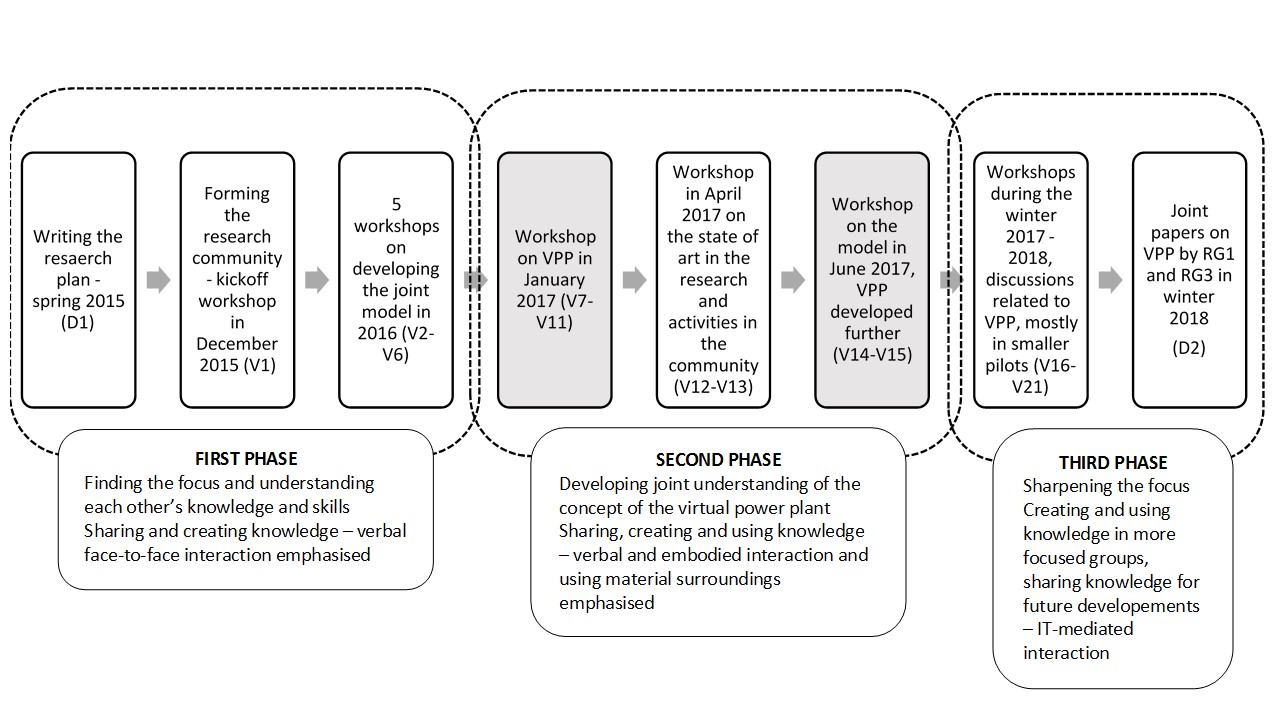
When analysing the interaction in the joint events of the community, it was concluded, that the dialogical and embodied nature of human beings was seen to affect the process. First of all, the meaning of face-to-face encounters and physical presence in the joint events was seen fundamental in developing situations, where knowledge was shared and created in interaction, especially in the first phases of the process.
Secondly, as we analysed the whole process of developing virtual power plant, we could conclude, that the process had different phases related to the type of interaction, modalities and tools used in the interaction. In the first phase, starting from the first meetings of the community in 2015, the gatherings were mostly organized so, that the members of the community used PowerPoint presentations and shared knowledge on their research, ideas and current state of affairs. Those presentations were freely interrupted by interactive phases. During this phase, verbal interaction and discussions were central, as the members of the community strived to clarify, what kinds of skills, knowledge and resources others had. In the second phase, it was indicated, that the knowledge creation concerning virtual power plant required more focused, and also materially facilitated interaction. Hence, two co-creation oriented workshops were organized. In January 2017, the community had a facilitated workshop, where different groups worked with post-its, papers and pens to develop their own concepts of virtual power plant. Furthermore, in June, 2017, a workshop with a loose timetable and open program was organized, to allow the community to interact and develop ideas more freely. In between those, a workshop on the current issues was organized in April 2017. During this second phase, in particular in workshops arranged in January 2017 and June 2017, the embodied nature of knowledge-creating human beings was highlighted. In order to get to sharpen the scientific and technological knowledge on virtual power plant, the dialogical, talk-oriented interaction was not enough, and the members of the community used several tools and material surroundings to support their interaction. In the third phase, the interaction was more focused and held privately, both face-to-face and especially by using e-mails. In the joint events, however, the interaction was concentrated most on sharing knowledge on the state of art of the developments, on discussing about further possibilities and on planning the empirical examination of the phenomena related to virtual power plant by using data gathered.
In this study, the workshops in January 2017 (V7-V11) and June 2017 (V14-V15) are focused, as they offer us possibilities to understand the limits of verbal interaction and illustrate the possibilities, which rise from the co-presence in the face-to-face discussions.
Embodied and dialogical nature of human beings illustrated in the discussions on virtual power plant
When analysing the knowledge-creating interaction in the phases, where verbal interaction was supplemented or substituted by embodied interaction in the selected workshops, we could identify three major ways of organizing the interaction: 1) using material surroundings and tools to get forward in the joint process of knowledge creation, 2) using embodied interaction, material surroundings and tools to clarify one’s own idea, and 3) using material surroundings, tools and embodied interaction to clarify or re-evaluate the content of previous knowledge. It should be noted, that in all these cases, different knowledge processes were present. In addition, we could notice, that when analysing longer processes, all the phenomena listed above were needed to be able to create more complex, scientific knowledge on virtual power plant. In this chapter, we present results of those analyses.
Material surroundings supporting the joint process of knowledge creation
As the participants of the research community’s workshops strived to develop conceptions for virtual power plant, one of the major challenges in face-to-face discussions was that the goal of the interaction was extremely complex and needed several concepts and smaller elements to be developed before any entity could be developed. Hence, the face-to-face discussions especially in the first workshop were constantly supplemented by using drawing, making notes and referring to the previous ideas and conceptions. Our analysis suggests, that the broader theme of the ideas could be formulated in discussion quite easily, as the participants had a shared understanding of many of the basic problems related to virtual power plant and creating market models for renewable energies. This understanding had been established in the previous workshops. Hence, the participants could proceed from more general discussions to quite exact and detailed ideation of some core conceptions related to virtual power plant relatively flexibly and quickly. In addition, in the workshops, where there were tools such as papers, pens and whiteboards available, they were immediately taken into use. Furthermore, it could be noted, that these tools were used as they were intended to by the organizers of the workshops, but also in many other ways.
One often occurring phenomenon was the use of material surroundings, such as notes and post-its flexibly in the knowledge-creating interaction, to both remind the participants of some previous idea or concept, or to foster the development of the idea by writing and thinking aloud together. This is illustrated in Example 1 (Figure 3), where a metheorologist (MET) and a member of the advisory board (AB) are trying to figure out, what kind of a marketplace is needed for virtual power plant (V8).
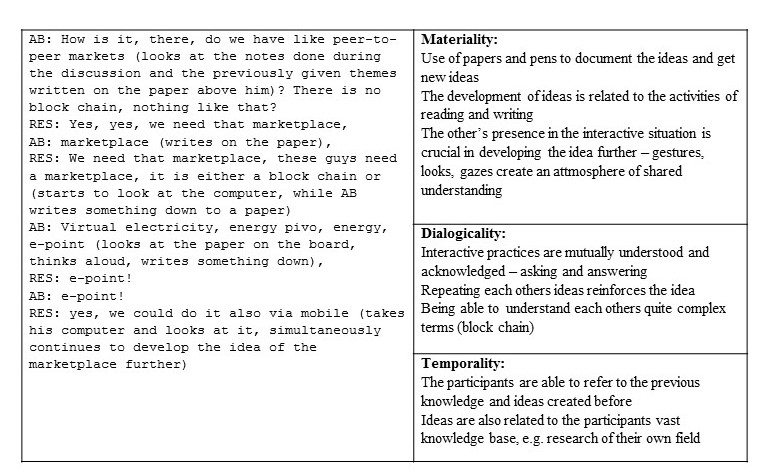
During the whole discussion, of which this is a short sequence, the paper where the notes of the discussion should be written to answer some pre-given questions, has played a big role. The participants have been able to discuss on their idea freely, and AB has simultaneously written some noted down on the paper. This kind of an activity is present also in Example 1, where the previous ideas developed have been written down and function now as an inspiration of the further development, as AB asks, if there is a need for peer-to-peer markets or blockchain. This gives ideas to the MET, whose embodied presence is exited, as he takes his computer and starts to look for something from there, while AB writes down the idea of the marketplace, repeating the word simultaneously. Furthermore, AB starts to develop a name for the marketplace, and even if the MET seems to be concentrated on his computer, he clearly listens to the ideation and is excited about the name e-point, which they mutually find a good idea and look at each other eagerly. However, they do not stop here, but go on developing the more complex idea of technically creating the marketplace.
One of the phenomena found in the data was related to the sharing knowledge by taking creatively into use the material surroundings. In Example 2 (Figure 4), the community starts to share their knowledge on the key issues and problems related to the development of the virtual power plant by starting to make a list on the whiteboard (V14). Computer science engineers (CSE1, CSE2, CSE3) and and economist (ECO) participate in the discussion. This activity is crucial in the knowledge creating process during the whole workshop (V14, V15).
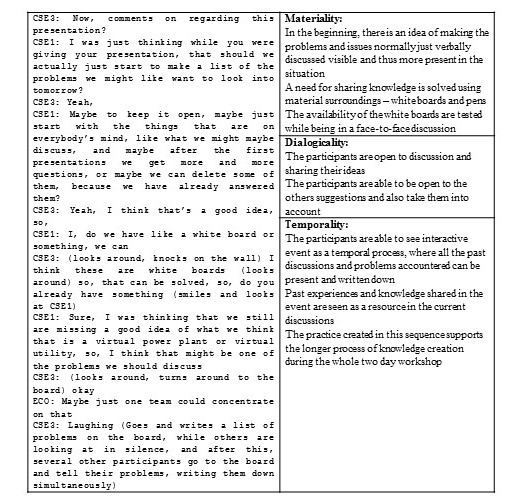
In this example, the material surroundings first support sharing knowledge, but as the discussion evolves and the practice of using whiteboards, drawing and writing continues, the participants can refer to the other’s ideas and whatever is on the board, it starts to function as a source of creating new knowledge together. This process continues throughout the whole workshop.
Embodied interaction and using tools to clarify one’s own ideas
Our analysis also illustrates, that using tools to share information or knowledge can also function as developing further one’s own ideas, as the participants explain their ideas and support the explanations by referring to tools. In Example 3 (Figure 5), a computer science engineer (CSE2) gets an idea based on his own field of expertise, and to support the explanation, he starts to look for something from his computer (V8). His participant, a member of the advisory board (AB) is listening actively.
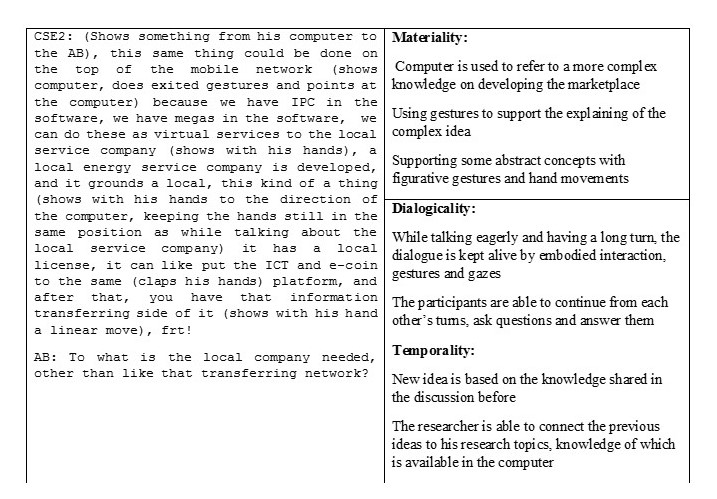
In this example we can see, that the long and technically detailed explanation functions primarily as a thinking aloud and creating an idea by the researcher. His embodied interaction illustrates excitement. Even if the partner does not continue in developing the technological side of the idea, he is able to understand the main points of the idea, and asks about the relevance of the local company.
One of the themes present in the discussions was the use of the weather forecasts in developing the virtual power plant. However, the complex nature of the issue has been complicating the process of combining the knowledge on weather forecasting to the whole system of virtual power plant. In Example 4 (Figure 6), the participants are able to tackle this challenge by using material surroundings, tools and embodied interaction (V10).
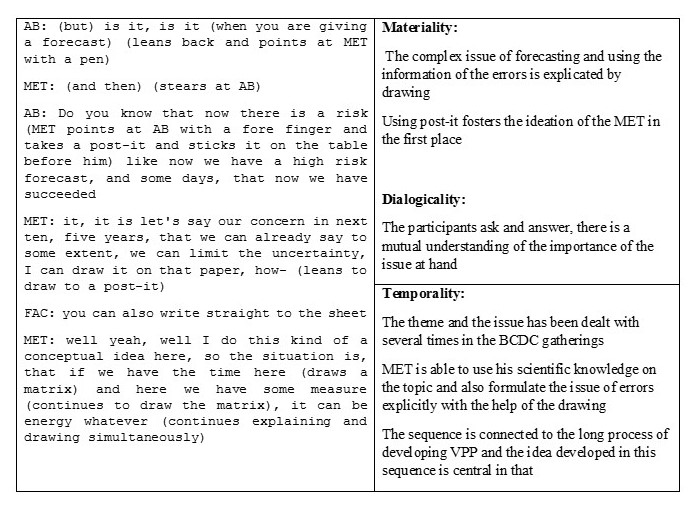
In this example, the researcher explicitly says, he is going to draw a concept of the modelling the weather and takes a post-it. To get to articulate a complex phenomenon related to forecasting errors, it is not possible to only talk, so using tools as simple as paper and pen is enough to clarify the idea, not only for the partner, but also for the researcher. In this discussion, the drawing happens simultaneously as the researcher talks, and he is able to develop the idea of using errors in a positive way to create new knowledge on the subject matter. The significance of the drawing itself is not only, or even not primarily on the information conveyed by the drawing, as it turns out, that the participant is not looking closely to the tiny note. It first and foremost acts as a tool to make visible and concrete the abstract idea of weather models. This is seen in the analysis of the whole sequence of interaction between the MET and AB, where the note is referred and explicitly pointed at, when wanting to take into account the whole, complex idea of weather modelling in the even more complex setting of developing virtual power plant. This is illustrated in Example 5 (Figure 7) (V10).
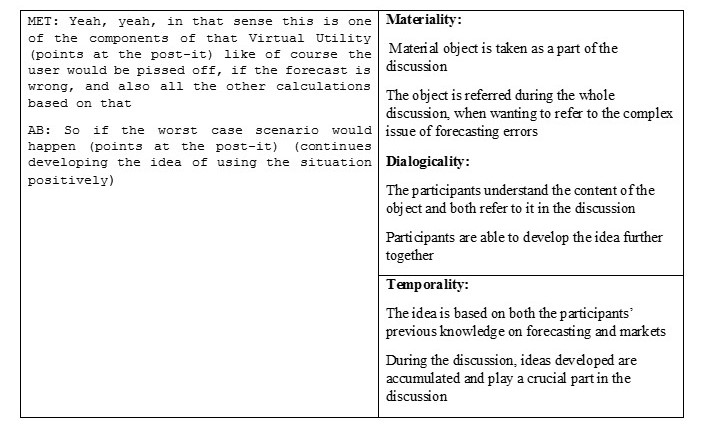
This kind of a phenomenon was present in all the other discussions in the workshops examined (OD, V7-V11, V14, V15).
Historical knowledge re-evaluated in the embodied interaction and by using the material surroundings
In general, the analysis suggests, that the fact that the community members could finally discuss about some key problems in their work face-to-face, in a surrounding where also writing and drawing was possible, was in itself supporting the knowledge creation related to virtual power plant in the second phase. Especially, it gave the participants possibilities to re-evaluate their previous knowledge on the topic, and jointly try to figure out best ways to proceed in the process. In Example 6 (Figure 8), the community is able to use the tools available for firstly, to share and clarify the understanding of the model for virtual power plant, and then proceed to create knowledge together. Before this sequence, the economist (ECO) has suggested, that the group could start the further development of virtual power plant by using the model developed by computer science engineers (CSE1, CSE2, CSE3) previously – however, it is suggested, they would combine that model with the knowledge gained in the discussions during the day (V14).
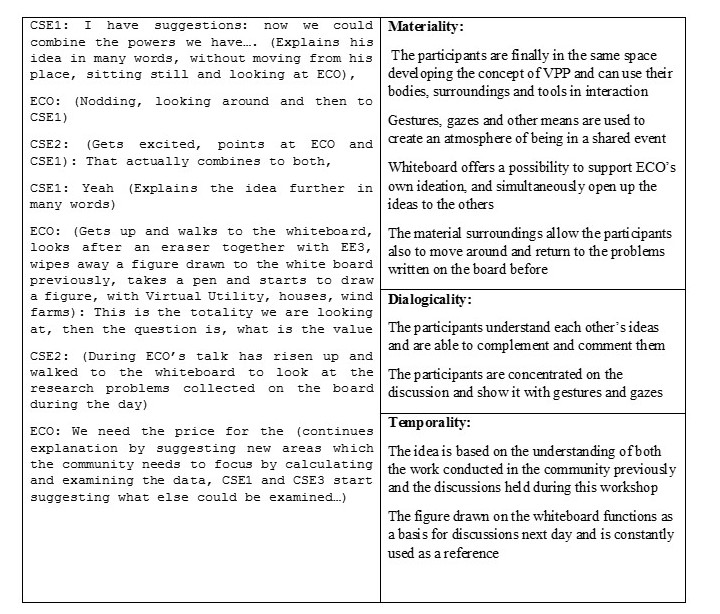
After minutes of discussion supported by drawing and referring to the figure drawn, several members of the community end up suggesting, how to continue the development of virtual power plant by doing actual empirical testing with existing data during the next workshop day (D15). Next day, this figure is central in keeping the discussions and research activities focused. In this example, we can see, how the environment and circumstances supporting joint knowledge creation are taken into use, and the community is able to step from discussing about the model, to actual empirical testing of the model by using data available.
The dialogical and embodied nature of the human beings could also be seen in the ways in which the community members strived to figure out the position of their research. In the next example, quite abstract discussion on the transdisciplinary, interdisciplinary and multidisciplinary nature of the research gets really concrete tone, as the participants are able to use whiteboard. This is illustrated in Example 7 (Figure 9) (V14).
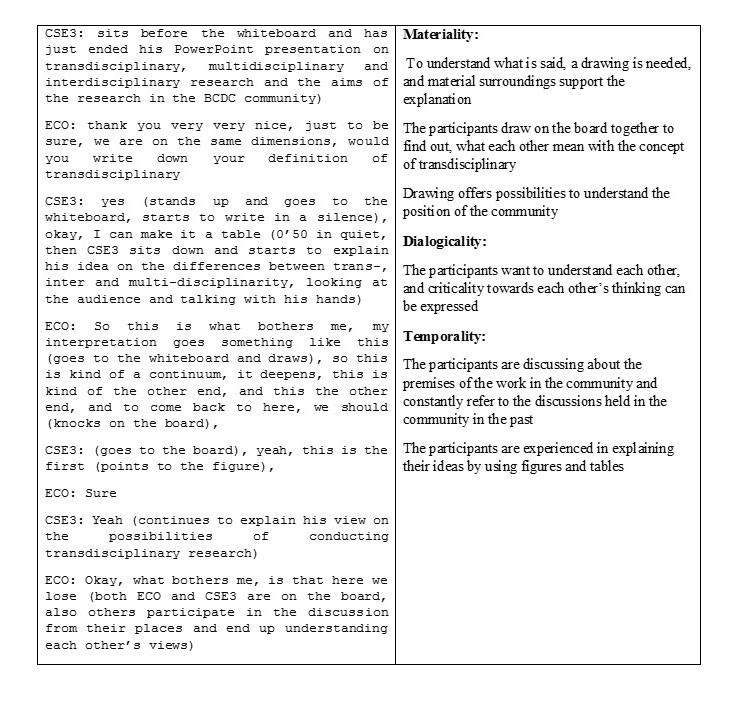
In the example, the community members do not understand each other’s views and ECO asks CSE3 to write his view on the whiteboard. CSE3 draws a table, which is then used as a physical reference in the discussions. During the discussion, the participants start to discuss with the terms like left, here, where are we, and are able to think about their position in the research, in the research community and in the field of science quite concretely, while also talking about really complex and abstract issues.
Discussion and conclusions
In this study, our research questions were: 1) How is the dialogical and embodied nature of the human beings shaping the knowledge creation process and 2) How is the knowledge creation process intertwined with the practices of sharing and using knowledge and information. The findings indicate, that the dialogical, embodied nature of human beings, experiencing the interactive event and participating in the discussions with gestures, gazes and movements, facilitates the knowledge creation process. In addition, to be able to create more complex knowledge, different kinds of tools and material surroundings were used frequently. We have illustrated, that examining knowledge creation as a dialogical, hermeneutic process enables us to see, how the problems faced in dialogical knowledge creation (Tsoukas, 2009) can be understood and solved by acknowledging the embodied nature of the human beings, their limits and possibilities. It should be noted, that the dimensions of materiality, dialogicality and temporality are all shaping the interaction and not to be understood as separate elements (Heidegger, 1985; Gadamer, 2004). However, in this study we have aimed at explicating the co-presence of all these dimensions in our analysis, to develop means to examine and understand the complex phenomenon of multi-modal interaction. In this study, the methods for examining interaction in the long and complex knowledge creation processes were developed, to analyse both the content and the modality of the interactive events. The ethnographical analysis of the whole process was crucial in understanding the interactive events examined in a detail - it enabled us to concentrate on the relevant sequences. Hence, our study contributes to the research of knowledge processes, interaction and practices (Budd, 2006; McKenzie, 2009, 2010; Tsoukas, 2009).
By concentrating on the materiality and embodied interaction we could proceed to examine the limits of the knowledge processes. First of all, human beings long for face-to-face discussions, but while present, they run out of words and tools, when striving to develop more complex, scientific knowledge. Therefore, there is a need to bridge the gap between the understanding of collaborative practices in face-to-face discussions and practices and tools needed to continue the processes, both in the course of the discussions, and when striving to continue the processes after the joint gatherings. Our analysis shows, that the flexible transitions from words to gestures and then to using tools, and back again, are crucial in developing more complex knowledge. In addition, our examination of the interaction illustrated, how knowledge creation, use and sharing are quite complexly present in the situations, where people act and interact in organisational gatherings. Our findings indicate, that the use of concrete, physical tools and material surroundings are facilitating the linkages between these processes. The embodied experiences and interaction in the information and knowledge processes could be further examined in relation to the research conducted on information practices (Olsson, 2016; Olsson and Lloyd, 2017) and information experience (Bruce et al., 2014; Latham, 2014; Gorichanaz, 2017).
The results can help in developing tools and practices to continue knowledge processes in the fragmented circumstances of the research work (Savolainen, 2009; White, 2007; O’Farrill, 2010). It is also important not to lose sight of the significance of what happens after the event of interaction: other events take place in different scenes of everyday living, and together they form a whole which eventually gives meaning to current activities and show the long term results of action. Hence, the understanding of the constraints rising from the temporal, dialogical and embodied nature of the human beings should be acknowledged, and examined also in relation to the structural and societal circumstances of work. In this examination, the phenomenological approach could be combined with the cultural historical tradition, combined also with the psychological traditions that acknowledge the societal nature of human beings (Holzkamp, 1996; Dreier, 2011; see also Wilson, 2008).
This study has limitations, as the analysis of interaction could focus only on the events videotaped. Hence, we could examine in a detail only the joint gatherings of the community. Hence, the examination of the private meetings and unofficial gatherings had to be excluded from the detailed analysis. However, those events could be discussed in the interviews of the participants, which could be used in the further studies examining the practices related to the writing of the scientific articles.
Acknowledgements
This study has been funded by the Strategic Research Council, Finland, Project no 292854.
About the authors
Anna Suorsa is a postdoctoral researcher interested in knowledge-creating interaction and co-creation in working communities. She works in Department of Information Studies, University of Oulu, Finland. She can be contacted at Anna.Suorsa@oulu.fi.
Teemu Suorsa is researcher, teacher, psychotherapist and post-doctoral research fellow in Department of Educational Psychology, University of Oulu, Finland. He can be contacted at teemu.suorsa@oulu.fi.
Rauli Svento is professor of economics at the Department of Economics in Oulu Business School, University of Oulu, Finland. His main research interest are in environmental and energy economics, regional economics and health economics. He can be contacted at rauli.svento@oulu.fi.
References
- Ahmad, F., & Widén, G. (2018). Knowledge sharing and language diversity in organisations: influence of code switching and convergence. European Journal of International Management, 12(4), 351-373.
- Alberts, D.J. (2007). A model of multidiscipline teams in knowledge-creating organizations. Team Performance Management, 13(5/6): 172–183.
- Auernhammer, J., & Hall, H. (2014). Organisational culture in knowledge creation, creativity and innovation: towards the Freiraum model. Journal of Information Science, 40(2): 154-166.
- Bruce, C., Davis, K., Huges, H., Partridge, H., & Stoodley, I. (2014). Information Experience: Contemporary Perspectives. In Bruce, C., Davis, K., Huges, H., Partridge, H. and Stoodley, I. (Eds.), Information Experience, Approaches to Theory and Practice (pp. 3-15). Bingley, Emerald.
- Budd, J.M. (2001). Knowledge and Knowing in Library and Information Science: A Philosophical Framewok. Lanham, Scarecrow Press.
- Budd, J.M. (2005). Phenomenology and information studies. Journal of Documentation, 61(1), 44–59.
- Budd, J.M. (2006). Discourse analysis and the study of communication in LIS. Library Trends, 55(1), 65–82.
- Cook, S.N. & Brown, J.S. (1999). Bridging epistemologies: the generative dance between organizational knowledge and organizational knowing. Organization Science, 10(4), 382–400.
- Cyr, S. & Choo, C.W. (2010). The individual and social dynamics of knowledge sharing: An exploratory study. Journal of Documentation, 66(6), 824–846.
- Dreier, O. (2011). Personality and the conduct of everyday life. Nordic Psychology, 63(2), 4–23.
- Gadamer, H.-G. (1999). Vom Zirkel des Verstehens. In: Gesammelte Werke 2: Hermeneutik II. Tübingen, J C B Mohr, 57–65.
- Gadamer, H.-G. (2004). Truth and Method. London/New York, Continuum.
- Gorichanaz, T. (2017). Auto-hermeneutics: A phenomenological approach to information experience. Library & Information Science Research, 39 (1), 1-7.
- Hansson, J. (2005). Hermeneutics as a bridge between the modern and the postmodern in library and information science. Journal of Documentation, 61 (1), 102–113.
- Heidegger, M. (1985). Being and time. Oxford, Blackwell.
- Hjørland, B. (2005). Empiricism, rationalism and positivism in library and information science. Journal of Documentation, 61 (1), 130–155.
- Hoel, I. (1992). Information science and hermeneutics - should information science be interpreted as a historical and humanistic science? In Vakkari, P & Cronin, B (Eds.), Conceptions of Library and Information Science: Historical, Empirical and Theoretical Perspectives (pp. 68-81). London: Taylor Graham.
- Holzkamp K. (1996). Psychologie: Selbstverständigung über Handlungsbegründungen alltäglicher Lebensführung. Forum Kritische Psychologie, 36, 7–74.
- Huvila I. (2019). Management of Archaeological Information and Knowledge in Digital Environment. In Handzic M., Carlucci D. (Eds.), Knowledge Management, Arts, and Humanities. Knowledge Management and Organizational Learning, vol 7 (pp. 147-169). Springer, Cham.
- Järvilehto, T. (1998). The theory of the organism–environment system I. Integrative Physiological & Behavioral Science, 33 (4), 321-334.
- Koloniari, M., Vraimaki, E., & Fassoulisa, K. (2018). Fostering Innovation in Academic Libraries Through Knowledge Creation. Journal of Academic Librarianship 44 (6), 793-804.
- Kosonen, M. (2008). Knowledge sharing in virtual communities. Lappeenranta, Lappeenrannan teknillinen yliopisto.
- Küpers, W. (2005). Phenomenology of embodied implicit and narrative knowing. Journal of Knowledge Management, 9 (6), 114–133.
- Küpers, W. (2015). Phenomenology of the Embodied Organization. The contribution of Merleau-Ponty for Organizational Studies and Practice. London, UK, Palgrave Macmillan.
- Latham, K.F. (2014). Experiencing documents. Journal of Documentation, 70 (4), 544–561.
- Linge, D.E. (2008). Editor’s Introduction. In Linge, E. (Ed.), Philosophical hermeneutics. Berkeley, University of California Press.
- Lopez, K.A. & Willis, D.G. (2004). Descriptive versus interpretive phenomenology: their contributions to nursing knowledge. Qualitative health research, 14 (5): 726–735.
- Lopez-Nicolas, C. & Soto-Acosta, P. (2010). Analyzing ICT adoption and use effects on knowledge creation: An empirical investigation in SMEs. International Journal of Information Management, 30: 521–528.
- Maso, I. (2001). Phenomenology and ethnography. In Atkinson, P., Coffey, A., Delamont, S., Lofland, J. & Lofland, L. (Eds.), Handbook of Ethnography (pp. 136-144). London: Sage.
- McKenzie, P.J. (2009). Informing Choice: The Organization of Institutional Interaction in Clinical Midwifery Care. Library & Information Science Research, 31(3), 163–173.
- McKenzie, P.J. (2010). Informing relationships: small talk, informing and relationship building in midwife-woman interaction. Information Research, 15(1) paper 423. [Available at http://InformationR.net/ir/15–1/paper423.html]
- Merleau-Ponty, M. (2006). Phenomenology of Perception. London and New York, Routledge.
- Mondada, L. (2012). The Conversation Analytic Approach to Data Collection. In Sidnell, J & Stivers, T (Eds.), The Handbook of Conversation Analysis (pp. 32-56). John Wiley & Sons, Chichester, West Sussex.
- Morner, M. & von Krogh, G. (2009). A note on knowledge creation in open-source software projects: what can we learn from Luhmann’s theory of social systems? Systemic Practice and Action Research, 22(6), 431–443.
- Moustakas, C.E. (1994). Phenomenological research methods. Thousand Oaks, California & London, SAGE.
- Organization Science, 5, 14-37.
- Nonaka, I. & Takeuchi, H. (1995). The knowledge-creating company. Oxford, Oxford University Press.
- O’Farrill, R.T. (2010). Information literacy and knowledge management at work: Conceptions of effective information use at NHS24. Journal of Documentation, 66(5), 706–733.
- Olsen, D.S. (2009). Emerging interdisclipinary practice: making nanoreactors. The Learning Organization, 16(5), 398–408.
- Olsson, M. (2016). Making sense of the past: The embodied information practices of field archaeologists, Journal of Information Science, 42(3), 410-419.
- Olsson, M. & Lloyd, A. (2017). Being in place: embodied information practices. Information Research, 22(1), CoLIS paper 1601. Retrieved from http://InformationR.net/ir/22-1/colis/colis1601.html (Archived by WebCite® at http://www.webcitation.org/6oJcFGlSg)
- Roth W.-M. (2007). On mediation: Toward cultural-historical understanding. Theory & Psychology, 17(5), 655–680.
- Savolainen, R. (2009). Information use and information processing. Journal of Documentation, 65(2), 187-207.
- Smith, V. (2001). Ethnographies of Work and the Work of Ethnographers. In Atkinson, P., Coffey, A., Delamont, S., Lofland, J. & Lofland, L. (Eds.), Handbook of Ethnography (pp. 220-233). London, Sage.
- Suominen, V. (2016). About and on behalf of scriptum est: The literary, bibliographic, and educational rationality sui generis of the library and librarianship on the top of what literature has produced. Oulu: University of Oulu.
- Suorsa, A. (2015a). Knowledge creation and play – a phenomenological approach. Journal of Documentation, 71 (3), 503-525.
- Suorsa, A. (2017). Knowledge creation and play - A phenomenological study within a multi-professional and multi-organizational community. Journal of Documentation, 73 (6), 1167-1191.
- Suorsa, T. (2015b). Toward a dialogue between systemic and subject-scientific approaches to psychological research into subjective experience. In Cresswell, J., Haye, A., Larrain, A., Morgan, M. & Sullivan, G. (Eds.), Dialogue and debate in the making of theoretical psychology (pp. 191-201). Concord, Captus.
- Suorsa, A. & Huotari, M.-L. (2014). Knowledge creation and the concept of human being – a phenomenological approach. Journal of the American Society for Information Science and Technology, 65(5), 1042-1067.
- Suorsa, A. & Huotari, M.-L. (2016). A methodology for studying knowledge creation in organizational settings. A phenomenological viewpoint. In Matthew Kelly & Jared Bielby (Eds.), Information cultures in the digital age: A festschrift in honor of Rafael Capurro (pp. 125-142). Zurich, Switzerland: Springer.
- Tsoukas, H. (2009). A Dialogical Approach to the Creation of New Knowledge in Organizations. Organization Science, 20(6), 941-957.
- Värlander, S. (2008). The interplay of reificative and participative processes of customer knowledge creation: An exploratory study of commercial lending. Journal of Financial Services Marketing, 12(4), 287–298.
- White, J.D. (2007). Knowledge sharing in a human resource community of practice. Walden University, US. ProQuest Dissertations and Theses, 233.
- Widén-Wulff, G. & Davenport, E. (2007). Activity systems, information sharing and the development of organizational knowledge in two Finnish firms: an exploratory study using Activity Theory. Information Research, 12(3), paper 310.
- Wilson, T.D. (2008). Activity theory and information seeking. Annual Review of Information Science and Technology, 42, 119–161.